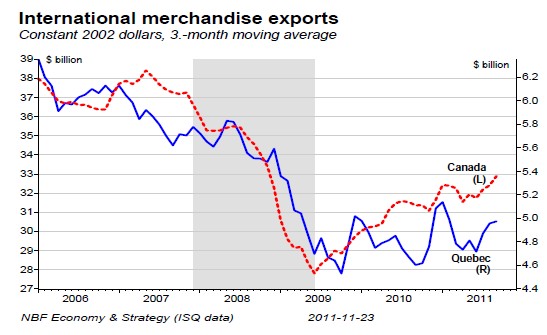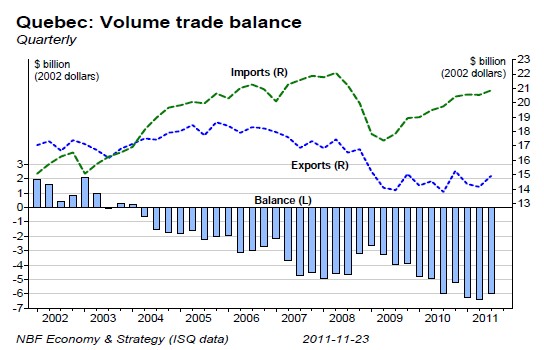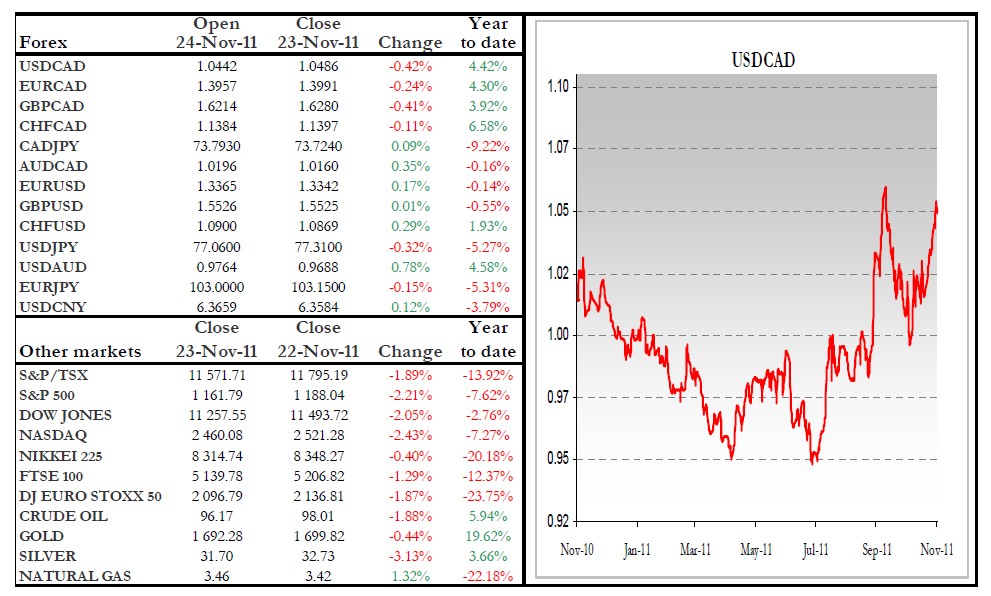The Institut de la statistique du Québec reports that Quebec’s trade deficit narrowed slightly in September, falling $60 million to $1.74 billion (top chart). Exports were down $8 million or 0.1%, with declines reported in 10 of 23 broad categories of goods accounting for 40% of total exports. A decrease of $128 million in aerospace products was offset by gains distributed across 13 of the major categories. Imports were down $67 million or 1.0%, with declines reported in 11 of 24 main categories accounting for 57% of all imports. Export prices rose 1.2% and import prices rose 2.6%. Thus in constant dollars exports were down 1.3% (Canada +2.2%) and imports were down 3.5% (Canada −3.4%).
OPINION: A 6.6% depreciation of the Canadian dollar against the greenback in September translated into rises in both export and import prices. If the August weighting of trade goods categories had been unchanged in September, the rise of export prices would have been almost equal to the rise of import prices. In other words, the steeper rise of import prices in September reflects a shift of the import mix toward goods whose prices had inflated more since the base year 2002. Be that as it may, the real trade deficit shrank in September. However, volume exports were down in September while rising for Canada as a whole, interrupting the Quebec catch-up trend visible earlier in Q3 (middle chart). We continue to think that the relative lethargy of Quebec international exports will hold the province’s economic growth to 1.6% in 2011. Meanwhile, since volume exports grew faster than volume imports in Q3, international trade contributed to Quebec’s economic growth over the quarter (bottom chart).


On track to meet fiscal targets
Highlights
For 2011-12 the Ontario government now expects a deficit of $16 billion, $0.3 billion less than budgeted last
March.
• Revenues are projected to fall $443 million short of the 2011 budget forecast. Excluding a loan repayment
from Chrysler Canada and other first-quarter changes, the shortfall would have been $778 million.
• The 2011 Budget plan included a $700 million reserve for 2011-12. The reserve has been reduced by $500 million to counter the impact of slower economic growth on fiscal performance.
• Program spending is consistent with the 2011 budget. Debt service is expected to cost $193 million less than budgeted.
• Deficit projections for the next two fiscal years are unchanged from the March budget. The effect of lower revenues and higher program spending is offset by a decrease in debt service cost.
• Real GDP growth is now projected at 1.8% in both 2011 and 2012, down from 2.4% and 2.7 % in the 2011 budget. The projection for 2013 is 2.5% and for 2014 it is 2.6%.
• The borrowing requirement is projected at $35 billion in 2011-12, $37.2 billion in 2012-13 and $40.0 billion in 2013-14. As of November 15th, 70% of the required 2011-12 borrowing had been completed.
• Debt resulting from accumulated deficits is estimated at 25.2% of GDP at the end of the current fiscal year and is projected to peak at 27.7% in 2014-15.
Opinion
To eliminate Ontario’s deficit by 2017-18, last spring’s budget targeted overall program spending growth of 1.4% annually. Given the current global economic uncertainty, the Commission on the Reform of Ontario’s Public Services is expected to recommend reducing the target to 1%. The government says it will consider this change in preparing the 2012 Budget.
A proposed Healthy Homes Renovation Tax Credit, projected to cost $60 million in 2011-2012, is to be financed entirely by reductions in business-support programs and tax expenditures. The measure would enable seniors or family members sharing a home with a senior to claim a tax credit of up to $1,500 for permanent modifications that improve accessibility or help a senior to be more functional or mobile at home.
The Province has continued to extend the maturity of its debt, locking in interest rates below those assumed in the 2011 budget. The total long-term public borrowing requirement over the next two years will be $3.6 billion lower than budgeted in March, primarily because of a lower-than-budgeted deficit in 2010-11 and the lower projected deficit in 2011-12. Borrowing in the current fiscal year will remain at the budgeted $35 billion to take advantage of historically low interest rates and robust demand for Ontario long-term debt. The Province has set aside $3.2 billion to buy back debt maturing over the next two fiscal years if opportunity arises.
Economic Commentary
Germany's failure to fuad funding on the prinaary market sent a troubling message to its leaders: The cancer of European sovereign debt has basally spread to their country. Berlin is stnwling with a rising risk related to the considerable weight of its troubled partners but still offers low returns, which draws fewer investors. This should lead the Germans to reflect on the advantages of the Euro...
Markets are closed south of the border today for Thanksgiving but the traditional turkey will have a bitter aftertaste for many investors. Stock markets were battered again yesterday, despite the usual drop-off in activity around lunchtime. Markets will probably be more stable through to the end of the week - however it could be a brutal return to work on Monday morning. It remains to be seen whether consumers will open their wallets tomorrow for Black Friday.
This is an excellent opportunity to review your hedging portfolio mad adjust your orders accordingly.
- English (UK)
- English (India)
- English (Canada)
- English (Australia)
- English (South Africa)
- English (Philippines)
- English (Nigeria)
- Deutsch
- Español (España)
- Español (México)
- Français
- Italiano
- Nederlands
- Português (Portugal)
- Polski
- Português (Brasil)
- Русский
- Türkçe
- العربية
- Ελληνικά
- Svenska
- Suomi
- עברית
- 日本語
- 한국어
- 简体中文
- 繁體中文
- Bahasa Indonesia
- Bahasa Melayu
- ไทย
- Tiếng Việt
- हिंदी
Trade deficit slightly smaller in September
Published 11/28/2011, 07:23 AM
Updated 05/14/2017, 06:45 AM
Trade deficit slightly smaller in September
FACTS:
Latest comments
Loading next article…
Install Our App
Risk Disclosure: Trading in financial instruments and/or cryptocurrencies involves high risks including the risk of losing some, or all, of your investment amount, and may not be suitable for all investors. Prices of cryptocurrencies are extremely volatile and may be affected by external factors such as financial, regulatory or political events. Trading on margin increases the financial risks.
Before deciding to trade in financial instrument or cryptocurrencies you should be fully informed of the risks and costs associated with trading the financial markets, carefully consider your investment objectives, level of experience, and risk appetite, and seek professional advice where needed.
Fusion Media would like to remind you that the data contained in this website is not necessarily real-time nor accurate. The data and prices on the website are not necessarily provided by any market or exchange, but may be provided by market makers, and so prices may not be accurate and may differ from the actual price at any given market, meaning prices are indicative and not appropriate for trading purposes. Fusion Media and any provider of the data contained in this website will not accept liability for any loss or damage as a result of your trading, or your reliance on the information contained within this website.
It is prohibited to use, store, reproduce, display, modify, transmit or distribute the data contained in this website without the explicit prior written permission of Fusion Media and/or the data provider. All intellectual property rights are reserved by the providers and/or the exchange providing the data contained in this website.
Fusion Media may be compensated by the advertisers that appear on the website, based on your interaction with the advertisements or advertisers.
Before deciding to trade in financial instrument or cryptocurrencies you should be fully informed of the risks and costs associated with trading the financial markets, carefully consider your investment objectives, level of experience, and risk appetite, and seek professional advice where needed.
Fusion Media would like to remind you that the data contained in this website is not necessarily real-time nor accurate. The data and prices on the website are not necessarily provided by any market or exchange, but may be provided by market makers, and so prices may not be accurate and may differ from the actual price at any given market, meaning prices are indicative and not appropriate for trading purposes. Fusion Media and any provider of the data contained in this website will not accept liability for any loss or damage as a result of your trading, or your reliance on the information contained within this website.
It is prohibited to use, store, reproduce, display, modify, transmit or distribute the data contained in this website without the explicit prior written permission of Fusion Media and/or the data provider. All intellectual property rights are reserved by the providers and/or the exchange providing the data contained in this website.
Fusion Media may be compensated by the advertisers that appear on the website, based on your interaction with the advertisements or advertisers.
© 2007-2024 - Fusion Media Limited. All Rights Reserved.
